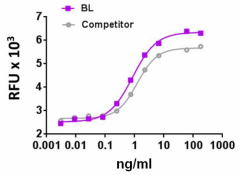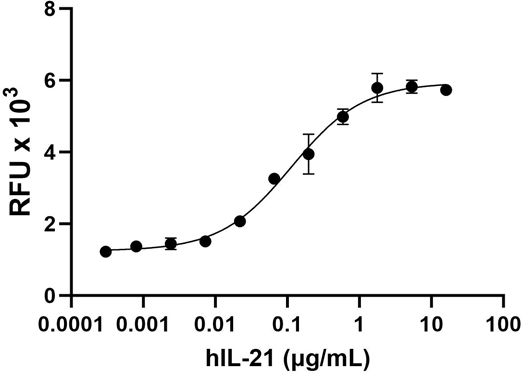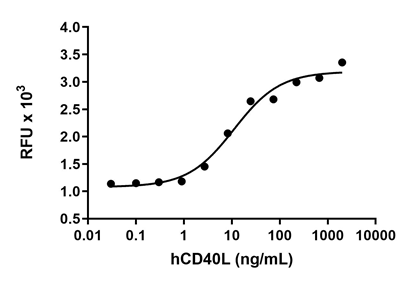- Regulatory Status
- RUO
- Other Names
- B cell activating factor belonging to the TNF family (BAFF), B lymphocytes stimulator (BLyS), TNF- and APOL-related leucocyte expressed ligand 1(TALL1), TNF homolog that activates apoptosis, NKFB, JNK (THANK), TNF13B, CD257
- Ave. Rating
- Submit a Review
- Product Citations
- publications

-

Recombinant human BAFF induces the proliferation of mouse B cells (stimulated with anti-IgM) in a dose dependent manner. BioLegend’s protein was compared side-by-side to the leading competitor’s equivalent product.
BAFF is a TNF-α cytokine member (a type II membrane protein) that acts in both a membrane-bound form and soluble cytokine form. The extracellular domain of BAFF shows high homology with APRIL. The soluble form is derived by cleavage in a furin consensus site. In human neutrophils treated with G-CSF, BAFF is processed intracellularly by a furin-type convertase. BAFF acts mainly as a soluble trimer and binds to three receptors with decreasing affinity in the following order: BAFFR > TACI > BCMA. Mice deficient in BAFF or its receptor BAFFR exhibit an obstruction in B cell development after the transitional T1 stage and lack marginal zone (MZ) and conventional B2 B cells. BAFFR-deficient mice and humans (patients with common variable immunodeficiency, or CVID) develop severe B cell lymphopenia due to the arrest of B cell development at the transitional B cell stage. Extreme BAFF production triggers severe autoimmune disorders in mice similar to Systemic Lupus Erythematosus (SLE) and Sjögren’s syndrome. BAFF has been associated with different human diseases such as pancreatic ductal adenocarcinoma (PDAC), autoimmune pancreatitis, SLE, rheumatoid arthritis, Sjögren's syndrome, lymphoid cancers, HIV infection, and B cell malignancies such as non-Hodgkin’s lymphoma (NHL).
Product DetailsProduct Details
- Source
- Human BAFF, amino acids (Ala134-Leu285) (Accession# NM_006573), was expressed with a N-terminal 9-His tag in CHO cells.
- Molecular Mass
- The 173 amino acid recombinant protein has a predicted molecular mass of approximately 19.2 kD. The protein migrates at approximately 20 kD in DTT-reducing and non-reducing conditions by SDS-PAGE. The predicted N-terminal amino acid is His.
- Purity
- >95%, as determined by Coomassie stained SDS-PAGE.
- Formulation
- 0.22 µm filtered protein solution is in 20mM NaH2PO4, 300mM NaCl, 2mM DTT, 1mM EDTA, 2mM CHAPS, and in pH 6.0.
- Endotoxin Level
- Less than 1 EU per µg cytokine as determined by the LAL method.
- Concentration
- 10 and 25 µg sizes are bottled at 200 µg/mL. 100 µg size and larger sizes are lot-specific and bottled at the concentration indicated on the vial. To obtain lot-specific concentration and expiration, please enter the lot number in our Certificate of Analysis online tool.
- Storage & Handling
- Unopened vial can be stored between 2°C and 8°C for up to 2 weeks, at -20°C for up to six months, or at -70°C or colder until the expiration date. For maximum results, quick spin vial prior to opening. The protein can be aliquoted and stored at -20°C or colder. Stock solutions can also be prepared at 50 - 100 µg/mL in appropriate sterile buffer, carrier protein such as 0.2 - 1% BSA or HSA can be added when preparing the stock solution. Aliquots can be stored between 2°C and 8°C for up to one week and stored at -20°C or colder for up to 3 months. Avoid repeated freeze/thaw cycles.
- Activity
- ED50 = 0.3 - 2.0 ng/mL, corresponding to a specific activity of 0.5 - 3.33 x 106 units/mg, as determined by the dose dependent stimulation of mouse B cells proliferation.
- Application
-
Bioassay
- Application Notes
-
BioLegend carrier-free recombinant proteins provided in liquid format are shipped on blue-ice. Our comparison testing data indicates that when handled and stored as recommended, the liquid format has equal or better stability and shelf-life compared to commercially available lyophilized proteins after reconstitution. Our liquid proteins are verified in-house to maintain activity after shipping on blue ice and are backed by our 100% satisfaction guarantee. If you have any concerns, contact us at tech@biolegend.com.
- Product Citations
-
Antigen Details
- Structure
- Cytokine.
- Distribution
-
Monocytes, macrophages, dendritic cells, neutrophils, and stromal cells of lymphoid organs.
- Function
- BAFF induces B cell maturation, proliferation, survival, and immunoglobulin production. BAFF controls the size and composition of mature preimmune B cell pools. BAFF is induced by INF-γ in monocytes.
- Interaction
- Immature B cells, peripheral B-cells, naïve and memory cells.
- Ligand/Receptor
- BAFFR, TACI (transmembrane activator and calcium-modulator and cyclophilin ligand interactor), and BCMA (B cell maturation antigen).
- Bioactivity
- Induces B cell proliferation.
- Cell Type
- Embryonic Stem Cells
- Biology Area
- Cell Biology, Costimulatory Molecules, Immunology, Signal Transduction, Stem Cells
- Molecular Family
- CD Molecules, Cytokines/Chemokines, Growth Factors, Soluble Receptors
- Antigen References
-
1. Schneider P, et al. 1999. J. Exp. Med. 189:1747.
2. Nardelli B, et al. 2001. Blood 97:198.
3. Schiemann B, et al. 2001. Science 5537:2111.
4. Scapini P, et al. 2003. J. Exp. Med. 197:297.
5. Yeramilli VA and Knight KL. 2010. J. Immunol. 184:5527.
6. Scholz JL and Cancro MP. 2012. Immunol. Lett. 143:2.
7. Sindhava VJ, et al. 2013. Front Immunol. 4:37.
8. Koizumi M, et al. 2013. PLoS One 8(8):e71367. - Gene ID
- 10673 View all products for this Gene ID
- UniProt
- View information about BAFF on UniProt.org
Related FAQs
- Why choose BioLegend recombinant proteins?
-
• Each lot of product is quality-tested for bioactivity as indicated on the data sheet.
• Greater than 95% Purity or higher, tested on every lot of product.
• 100% Satisfaction Guarantee for quality performance, stability, and consistency.
• Ready-to-use liquid format saves time and reduces challenges associated with reconstitution.
• Bulk and customization available. Contact us.
• Learn more about our Recombinant Proteins. - How does the activity of your recombinant proteins compare to competitors?
-
We quality control each and every lot of recombinant protein. Not only do we check its bioactivity, but we also compare it against other commercially available recombinant proteins. We make sure each recombinant protein’s activity is at least as good as or better than the competition’s. In order to provide you with the best possible product, we ensure that our testing process is rigorous and thorough. If you’re curious and eager to make the switch to BioLegend recombinants, contact your sales representative today!
- What is the specific activity or ED50 of my recombinant protein?
-
The specific activity range of the protein is indicated on the product datasheets. Because the exact activity values on a per unit basis can largely fluctuate depending on a number of factors, including the nature of the assay, cell density, age of cells/passage number, culture media used, and end user technique, the specific activity is best defined as a range and we guarantee the specific activity of all our lots will be within the range indicated on the datasheet. Please note this only applies to recombinants labeled for use in bioassays. ELISA standard recombinant proteins are not recommended for bioassay usage as they are not tested for these applications.
- Have your recombinants been tested for stability?
-
Our testing shows that the recombinant proteins are able to withstand room temperature for a week without losing activity. In addition the recombinant proteins were also found to withstand four cycles of freeze and thaw without losing activity.
- Does specific activity of a recombinant protein vary between lots?
-
Specific activity will vary for each lot and for the type of experiment that is done to validate it, but all passed lots will have activity within the established ED50 range for the product and we guarantee that our products will have lot-to-lot consistency. Please conduct an experiment-specific validation to find the optimal ED50 for your system.
- How do you convert activity as an ED50 in ng/ml to a specific activity in Units/mg?
-
Use formula Specific activity (Units/mg) = 10^6/ ED50 (ng/mL)
 Login/Register
Login/Register 














Follow Us